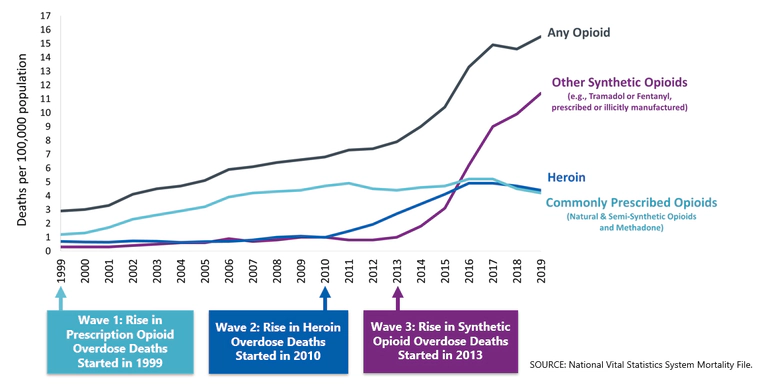Emerging Opioid Threat From New Synthetic Drug
Nitazenes are a new type of opioid drug said to be 800 times more potent than morphine and 40 times more potent than fentanyl.

There is an emerging opioid drug trend that parents, educators, public health officials, and everyday Americans should be aware of. The introduction of nitazenes, a super-potent opioid said to be 800 times more potent than morphine, is a pharmaceutical development that poses a serious risk to Americans.
Because this new nitazene class of opioids is so potent and so easily lethal, most analysts don’t yet believe nitazenes will replace fentanyl and other high-strength opioids in the medical settings where pain relief drugs are frequently utilized. But much like fentanyl, carfentanil, prescription painkillers, and so many other opioids, nitazene-based drugs may still find their way into clandestine drug batches. Whether the FDA approves nitazenes for human consumption or not, such drugs could cause the next major opioid crisis, particularly among addicts who do not know this new opioid is in their drug supply.
The recent emergence of nitazene opioid drugs is further evidence that addicts are at immense risk and must seek treatment as soon as possible.
What are Nitazenes?
Opioids refer to a broad class of drugs with similar chemical components but which possess some inherent differences from one drug to the next. Nitazenes are a specific subclass of opioids that work on a particular opioid receptor in the brain. Nitazenes fall into the category of synthetic opioids, which is an opioid drug that is synthesized in a lab rather than produced from the opium poppy plant.1
There are a few concerning developments worth mentioning right away. First, synthetic opioids were responsible for 60% of all drug overdose deaths in 2020. Second, nitazenes are said to be far more potent than other synthetic opioids. Further, nitazene-based opioids have already been detected in many parts of the U.S., including the Southwest, South, Midwest and some areas on the East Coast. Three types of nitazenes that have been detected in drug labs across the U.S. but which have not been approved for human consumption are Isotonitazene, Metonitazene, and Etonitazene.
Though the researchers who developed nitazenes received a patent for doing so, nitazenes have never been approved for use by the Food and Drug Administration. Thomas So, senior manager of the Consumer Drug Information Group, has said that nitazenes have no legitimate medicinal purposes. Further, nitazenes are about 800 times more potent than morphine and 40 times more potent than fentanyl. So even if the drugs could serve a role in medicine, it would be next to impossible to prescribe a safe dose. Inherent risks in prescribing the drug would far outweigh any alleged benefit.
The Cost of Opioid Addiction

Sadly, although news of nitazene emergence has yet barely circulated, it is thought that these drugs have already led to some overdose deaths in the United States. However, it is very difficult to record how many people are dying from specific types of opioids, just that opioid deaths are shockingly high and getting higher each year. But based on the research data that is available, Alex J. Krotulski, the associate director of the Center for Forensic Science Research & Education, has estimated about 1,000 to 2,000 Americans have died from nitazenes since 2019.
Verified deaths from nitazenes have been reported in these states:
- Indiana
- Illinois
- Minnesota
- Wisconsin
Law enforcement officers have seized nitazenes in these states:
- California
- Iowa
- Louisiana
- New Jersey
- New York
- Pennsylvania
Another particularly sinister aspect of the spread of nitazenes across the nation is that most addicts who use this type of opioid do so without knowing they are using it. Quoting Dr. Ryan Marino, assistant professor of emergency medicine at Case Western School of Medicine, “People are not intentionally ingesting nitazenes for the most part. People are in effect being poisoned when they’re purchasing what they believe is heroin or fentanyl.” As with many highly potent synthetic opioids, addicts have no way of knowing what type of opioid they are consuming. They could be taking a far more potent drug than they think; a substance that could easily cause an overdose.
“People are not intentionally ingesting nitazenes for the most part. People are in effect being poisoned when they’re purchasing what they believe is heroin or fentanyl.”
The cost of opioid addiction in America is exorbitant. According to the United States Department of Health and Human Services, about 10.1 million Americans over the age of 12 were thought to have abused opioids in 2019, with at least 9 million misusing prescription painkillers. The HHS also reports that since the opioid epidemic began in 1999, about 760,000 Americans have died from drug overdoses and two-thirds of those deaths were caused by opioid overdoses.2

Courtesy of CDC.gov
The Centers for Disease Control and Prevention reports that, while prescription opioid pain relievers may have launched the opioid epidemic in the late-1990s, and while heroin addiction may have continued the epidemic in the 2000s, it is now synthetic opioids that are carrying the epidemic forward into the present (and potentially the future). Today, the vast majority of opioid-related deaths involve synthetic opioids.3
If nitazenes make a prominent entrance into the drug supply, it would will likely result in a significant increase in drug overdoses.
Sources:
-
US News. “What Are Nitazenes?” US News, 2022. US News Article ↩︎
-
HHS “Opioid Facts and Statistics.” US Department of Health and Human Services, 2022. HHS.gov ↩︎
-
Centers for Disease Control and Prevention. “Understanding the Epidemic.” CDC, 2021. CDC Article ↩︎







 ®
®